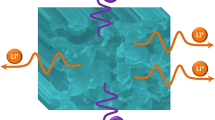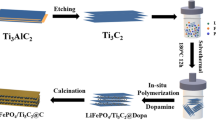Abstract
Lithium iron silicate has caught tremendous attentions as an appealing cathode for future lithium-ion batteries due to high capacity, low cost, and environmental friendliness, and its drawback of extremely low conductivity can be overcome efficiently through nanoarchitecture building. However, the construction of nanostructures always involves with expensive surfactants and complicated synthetic processes, which restrict these methods from large-scale production. In this paper, we develop a simple synthetic route to prepare hierarchical porous Li2FeSiO4/C. XRD, SEM, TEM, Raman, and N2 adsorption-desorption are employed to investigate its physical properties. Electrochemical tests reveal that the composite delivers a high specific capacity of 243.5 mAh g−1, superior rate capability, and excellent cycling performance with capacity retention of 95.2% after 200 cycles. The excellent electrochemical performance should be attributed to the unique structure in which hierarchical pores provides fast transport channels for lithium ions and interconnected carbon coating builds up conductive networks to enhance the conductivity of Li2FeSiO4. In addition, electrochemical impedance spectroscopy, ex situ SEM, and TEM are conducted to demonstrate its structural stability upon long-term cycling. In addition, the route described in this work is facile, cheap, and easily scaled-up, which allows for extension to the fabrication of other energy storage materials.









Similar content being viewed by others
References
Whittingham MS (2014) Ultimate limits to intercalation reactions for lithium batteries. Chem Rev 114(23):11414–11443. https://doi.org/10.1021/cr5003003
Masquelier C, Croguennec L (2013) Polyanionic (phosphates, silicates, sulfates) frameworks as electrode materials for rechargeable Li (or Na) batteries. Chem Rev 113(8):6552–6591. https://doi.org/10.1021/cr3001862
Gao XP, Yang HX (2010) Multi-electron reaction materials for high energy density batteries. Energy Environ Sci 3(2):174–189. https://doi.org/10.1039/B916098A
Armstrong AR, Kuganathan N, Islam MS, Bruce PG (2011) Structure and lithium transport pathways in Li2FeSiO4 cathodes for lithium batteries. J Am Chem Soc 133(33):13031–13035. https://doi.org/10.1021/ja2018543
Eames C, Armstrong AR, Bruce PG, Islam MS (2012) Insights into changes in voltage and structure of Li2FeSiO4 polymorphs for lithium-ion batteries. Chem Mater 24(11):2155–2161. https://doi.org/10.1021/cm300749w
Hu L, Yang J, Amiinu IS, Kang X, Zhang W, Mu S (2015) Lithium storage properties of in situ synthesized Li2FeSiO4 and LiFeBO3 nanocomposites as advanced cathode materials for lithium ion batteries. J Mater Chem A 3(46):23368–23375. https://doi.org/10.1039/C5TA04588F
Nytén A, Kamali S, Häggström L, Gustafsson T, Thomas JO (2006) The lithium extraction/insertion mechanism in Li2FeSiO4. J Mater Chem 16(23):2266–2272. https://doi.org/10.1039/B601184E
Sirisopanaporn C, Boulineau A, Hanzel D, Dominko R, Budic B, Armstrong AR, Bruce PG, Masquelier C (2010) Crystal structure of a new polymorph of Li2FeSiO4. Inorg Chem 49(16):7446–7451. https://doi.org/10.1021/ic100741x
Tan R, Yang J, Zheng J, Wang K, Lin L, Ji S, Liu J, Pan F (2015) Fast rechargeable all-solid-state lithium ion batteries with high capacity based on nano-sized Li2FeSiO4 cathode by tuning temperature. Nano Energy 16:112–121. https://doi.org/10.1016/j.nanoen.2015.06.016
Du X, Zhao H, Lu Y, Gao C, Xia Q, Zhang Z (2016) Electrochemical properties of nanostructured Li2FeSiO4/C synthesized by a simple coprecipitation method. Electrochim Acta 188:744–751. https://doi.org/10.1016/j.electacta.2015.12.039
Hörmann NG, Groß A (2013) Stability, composition and properties of Li2FeSiO4 surfaces studied by DFT. J Solid State Electr 18(5):1401–1413
Masese T, Tassel C, Orikasa Y, Koyama Y, Arai H, Hayashi N, Kim J, Mori T, Yamamoto K, Kobayashi Y, Kageyama H, Ogumi Z, Uchimoto Y (2015) Crystal structural changes and charge compensation mechanism during two lithium extraction/insertion between Li2FeSiO4 and FeSiO4. J Phys Chem C 119(19):10206–10211. https://doi.org/10.1021/acs.jpcc.5b00362
Su D, Ahn H, Wang G (2011) Ab initio calculations on li-ion migration in Li2FeSiO4 cathode material with a P 21 symmetry structure. Appl Phys Lett 99(14):141909. https://doi.org/10.1063/1.3645617
Nitta N, Wu F, Lee JT, Yushin G (2015) Li-ion battery materials: present and future. Mater Today 18(5):252–264. https://doi.org/10.1016/j.mattod.2014.10.040
Zhang Y, Li Y, Xia X, Wang X, Gu C, Tu J (2015) High-energy cathode materials for li-ion batteries: a review of recent developments. Sci China Technol Sci 58(11):1809–1828. https://doi.org/10.1007/s11431-015-5933-x
Islam MS, Dominko R, Masquelier C, Sirisopanaporn C, Armstrong AR, Bruce PG (2011) Silicate cathodes for lithium batteries: alternatives to phosphates? J Mater Chem 21(27):9811–9818. https://doi.org/10.1039/c1jm10312a
Nakano H, Dokko K, Koizumi S, Tannai H, Kanamura K (2008) Hydrothermal synthesis of carbon-coated LiFePO4 and its application to lithium polymer battery. J Electrochem Soc 155(12):A909–A914. https://doi.org/10.1149/1.2988048
Xie HM, Wang RS, Ying JR, Zhang LY, Jalbout AF, HY Y, Yang GL, Pan XM, ZM S (2006) Optimized LiFePO4–Polyacene cathode material for lithium-ion batteries. Adv Mater 18(19):2609–2613. https://doi.org/10.1002/adma.200600578
Nishimura SI, SH RK, Yashima M, Nakayama N (2008) Structure of Li2FeSiO4. J Am Chem Soc 130(40):13212–13213. https://doi.org/10.1021/ja805543p
Zhang Z, Liu X, Wu Y, Zhao H (2014) Graphene modified Li2FeSiO4/C composite as a high performance cathode material for lithium-ion batteries. J Solid State Electr 19:469–475
Yang J, Kang X, He D, Zheng A, Pan M, Mu S (2015) Graphene activated 3D-hierarchical flower-like Li2FeSiO4 for high-performance lithium-ion batteries. J Mater Chem A 3(32):16567–16573. https://doi.org/10.1039/C5TA03874J
Rangappa D, Murukanahally KD, Tomai T, Unemoto A, Honma I (2012) Ultrathin nanosheets of Li2MSiO4 (M = Fe, Mn) as high-capacity Li-ion battery electrode. Nano Lett 12(3):1146–1151. https://doi.org/10.1021/nl202681b
Qiu H, Zhu K, Li H, Li T, Zhang T, Yue H, Wei Y, Du F, Wang C, Chen G, Zhang D (2015) Mesoporous Li2FeSiO4@ordered mesoporous carbon composites cathode material for lithium-ion batteries. Carbon 87:365–373. https://doi.org/10.1016/j.carbon.2015.02.056
Chen Z, Qiu S, Cao Y, Qian J, Ai X, Xie K, Hong X, Yang H (2013) Hierarchical porous Li2FeSiO4/C composite with 2 Li storage capacity and long cycle stability for advanced Li-ion batteries. J Mater Chem A 1(16):4988–4992. https://doi.org/10.1039/c3ta00611e
Li D, Zhang W, Sun R, Yong HT, Chen G, Fan X, Gou L, Mao Y, Zhao K, Tian M (2016) Soft-template construction of three-dimensionally ordered inverse opal structure from Li2FeSiO4/C composite nanofibers for high-rate lithium-ion batteries. Nano 8:12202–12214
Wu X, Wang X, Zhang Y (2013) Nanowormlike Li2FeSiO4-C composites as lithium-ion battery cathodes with superior high-rate capability. ACS Appl Mater Interfaces 5(7):2510–2516. https://doi.org/10.1021/am303047n
Yang J, Hu L, Zheng J, He D, Tian L, Mu S, Pan F (2015) Li2FeSiO4 nanorods bonded with graphene for high performance batteries. J Mater Chem A 3(18):9601–9608. https://doi.org/10.1039/C5TA01529D
Wu X, Jiang X, Huo Q, Zhang Y (2012) Facile synthesis of Li2FeSiO4/C composites with triblock copolymer P123 and their application as cathode materials for lithium ion batteries. Electrochim Acta 80:50–55. https://doi.org/10.1016/j.electacta.2012.06.122
Zheng Z, Wang Y, Zhang A, Zhang T, Cheng F, Tao Z, Chen J (2012) Porous Li2FeSiO4/C nanocomposite as the cathode material of lithium-ion batteries. J Power Sources 198:229–235. https://doi.org/10.1016/j.jpowsour.2011.09.066
Hung IM, Yang Y-C, H-J S, Zhang J (2015) Influences of the surfactant on the performance of nano-LiMn2O4 cathode material for lithium-ion battery. Ceram Int 41:S779–S786. https://doi.org/10.1016/j.ceramint.2015.03.292
Yang J, Kang X, Hu L, Gong X, He D, Peng T, Mu S (2013) Synthesis and electrochemical performance of Li2FeSiO4/C/carbon nanosphere composite cathode materials for lithium ion batteries. J Alloy Compd 572:158–162. https://doi.org/10.1016/j.jallcom.2013.03.256
Fu R, Li Y, Yang H, Zhang Y, Cheng X (2013) Improved performance of Li2FeSiO4/C composite with highly rough mesoporous morphology. J Electrochem Soc 160(5):A3048–A3053. https://doi.org/10.1149/2.009305jes
Yang J, Kang X, Hu L, Gong X, Mu S (2014) Nanocrystalline-Li2FeSiO4 synthesized by carbon frameworks as an advanced cathode material for Li-ion batteries. J Mater Chem A 2(19):6870–6878. https://doi.org/10.1039/C3TA15111E
Zhang LL, Duan S, Yang XL, Peng G, Liang G, Huang YH, Jiang Y, Ni SB, Li M (2013) Reduced graphene oxide modified Li2FeSiO4/C composite with enhanced electrochemical performance as cathode material for lithium ion batteries. ACS Appl Mater Interfaces 5(23):12304–12309. https://doi.org/10.1021/am402434n
Hao H, Wang JB, Liu JL, Huang T, Yu A (2012) Synthesis, characterization and electrochemical performance of Li2FeSiO4/C cathode materials doped by vanadium at Fe/Si sites for lithium ion batteries. J Power Sources 210:397–401. https://doi.org/10.1016/j.jpowsour.2011.11.066
Acknowledgements
We thank the National Key Research Program of China (No. 2016YFB0901501), the Research Project of State Grid Corporation of China (No. 521702160004), and the China Postdoctoral Science Foundation (2016M592383, 2017T100574) for the financial support.
Author information
Authors and Affiliations
Corresponding author
Rights and permissions
About this article
Cite this article
Pu, X., Zhao, G., Ding, F. et al. Facile synthesis of hierarchical porous Li2FeSiO4/C as highly stable cathode materials for lithium-ion batteries. J Solid State Electrochem 22, 877–884 (2018). https://doi.org/10.1007/s10008-017-3827-5
Received:
Revised:
Accepted:
Published:
Issue Date:
DOI: https://doi.org/10.1007/s10008-017-3827-5




